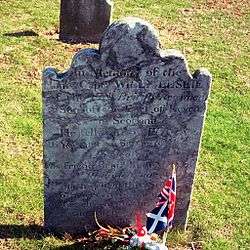William Leslie (British Army officer)
| William Leslie | |
|---|---|
 Leslie's Gravestone | |
| Born |
8 August 1751 Fife, Scotland |
| Died |
3 January 1777 (aged 25) Princeton, New Jersey, United States |
| Buried at |
St. Paul's Lutheran Church graveyard Pluckemin, New Jersey, United States |
| Allegiance |
|
| Service/branch |
|
| Rank | Captain |
| Battles/wars | |
The Honourable William Leslie (8 August 1751 – 3 January 1777), second son of the Earl of Leven and Melville from Scotland, was a Captain in the 17th Foot of the British Army during the American War of Independence. He was mortally wounded during the Battle of Princeton and buried with military honours by American General George Washington at Pluckemin, New Jersey.
Early life
He was born on 8 August 1751 to David Leslie, 6th Earl of Leven and Wilhelmina Nisbet.[1] He was the nephew of General Alexander Leslie.[2]
During the summer of 1767, he became a friend of Benjamin Rush, who was then studying medicine at University of Edinburgh and had visited the estate of the Earl of Leven.[2][3]
Military career
In 1771, he joined the 42nd Highlanders. He next switched to the 17th Foot and was promoted to lieutenant in 1773, and to captain in 1776.[1] Sent to America in 1776, he served in the Battle of Long Island and the Battle of Fort Washington.[1]
On 3 January 1777, during the Battle of Princeton, he was one of many who died.[4] The British put his body in a wagon, that was later taken by the Americans. The following day, Rush, while treating the wounded at Princeton, learned of Leslie's death from British Captain John McPherson.[5] On 5 January, at Pluckemin, when General George Washington learned that Leslie was a friend of Rush, he ordered military honours for the burial.[5][6] The gravestone is in the graveyard of the former St. Paul's Lutheran Church (built 1757), where the Pluckemin Presbyterian Church is now located.[7]
Legacy

In The Death of General Mercer at the Battle of Princeton, January 3, 1777 the painter John Trumbull displays several events of the battle. At the centre, General Hugh Mercer, with his dead horse beneath him, is mortally wounded. At the left, Captain Daniel Neil[8] is bayoneted against a cannon. At the right, Leslie is shown mortally wounded. In the background, Washington and Rush enter the scene.[9]
After the war, Dr. Benjamin Rush placed a gravestone in Leslie's memory at the Pluckemin graveyard. As the original had crumbled, a replacement with the same inscription was erected c. 1836 by Professor Ogilby of Rutgers University[10] at the request of David Leslie-Melville, 8th Earl of Leven.[1] His gravestone is honoured by both British and Scottish flags.
In Memory of the |
References
- 1 2 3 4 Fraser (1890), pp. 350–1.
- 1 2 Fischer (2006), p. 311.
- ↑ Hawke (1971), p. 51.
- ↑ Fischer (2006), p. 331.
- 1 2 Hawke (1971), p. 180.
- ↑ Rodney, Thomas (1776–1777). Diary of Captain Thomas Rodney. pp. 39–40.
- ↑ Ashton, Charles H. (26 July 1982). "NRHP Nomination: Pluckemin Village Historic District" (PDF). National Park Service: 17.
- ↑ Fischer (2006), p. 333.
- ↑ "The Death of General Mercer at the Battle of Princeton, January 3, 1777 (Descriptive data)". Yale University Art Gallery.
- ↑ Honeyman, A. Van Doren, ed. (1919). "The Leslie Tombstone at Pluckemin". Somerset County Historical Quarterly. 8. pp. 230–1.
Bibliography
- Fischer, David Hackett (2006). Washington's Crossing. Oxford University Press. ISBN 0-19-517034-2.
- Fraser, William (1890). The Melvilles, earls of Melville, and the Leslies, earls of Leven.
- Hawke, David Freeman (1971). Benjamin Rush: Revolutionary Gadfly.
External links
- Capt William Leslie at Find a Grave
- "Pluckemin Cemetery Captain William Leslie's Grave". Crossroads of the American Revolution.
- "Captain William Leslie". The Silver Whistle.